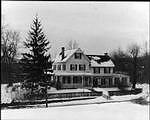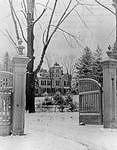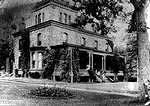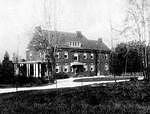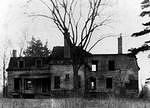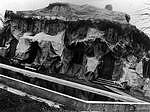Vanished Houses
A number of historic houses have survived more than 200 years in Palisades. They include the Big House, the Ding-Dong House, the Mann house and the Captain John house on Washington Spring Road, as well as the Nicholas Gesner house, the Willsey house, and Chimney Cottage on Closter Road. Many more old houses have disappeared forever, in most cases leaving no trace. We are fortunate to have photographs of a few of the vanished houses.
The Abram Post house on Closter Road (above) is shown on the Erskine map of 1780. This old stone Dutch house may have been built by Jacob Post about 1765. It - or its replacement - burned down in 1909. The Zinnell house, 47 Closter Road, was built in 1911 on the site of the old Post house.
Tradition says the David Mann house (left) was built in 1793 by David Mann, one of the sons of the George Mann who built a house on Washington Spring Road in 1784. It was originally a stone house in the Dutch style, but was greatly altered in the 19th century. A porch, a wing, and a second story were added. The farmer David Mann, a grandson of the original builder, was living in the house at the beginning of the 20th century. It was torn down in 1955 when the Palisades Parkway came through Palisades.
The Marder house (right) was built around the beginning of the 20th century on land purchased from David Mann. It was located on the north side of Oak Tree Road, partway down the hill, and was torn down before 1913 to be replaced by the Perry house.
The Austin Abbott house (left) was located inside Tallman State Park, at the end of the road, overlooking the river. It had been built by Peter King in 1867 and was torn down in 1932, after the Standard Oil property was acquired by Tallman Park. Holly Post's horses fell over the cliff here once, while delivering ice, but were rescued unharmed.
The Perry house (right) was built in 1913, replacing the Marder house. Mrs. John Perry was a Marder. Their only son, John Marder Perry, was killed in World War I. The Perrys built the American Legion Hall on Route 340, the John M. Perry Post, in his memory. In 1970 this house was torn down and replaced by Palisades Gardens, a residence for senior citizens, now the Esplanade.
Heyhoe (left), shown here after the fire that destroyed it in the 1930s, was probably built by Warren Gilbert in 1841. In 1871 Winthrop Gilman Senior, father of the Winthrop Gilman who built Niederhurst, bought the house and lived in it until he died in 1884. It is said that the doorknobs were of solid silver and the house had 26 marble fireplaces.
The Nessler house (right) was built by Karl Nessler, who invented the permanent wave in England in 1906. He came here after World War II and opened a series of salons, probably building the house in the 1920s. The walls of the house were made of a very unusual kind of stone. It was replaced in the late 1950s by a development called Palisades Gardens.



